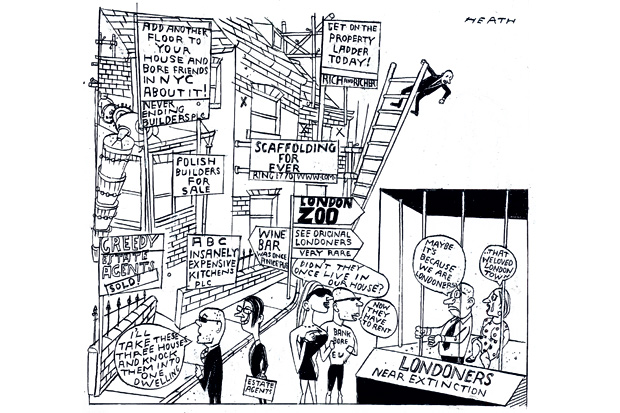‘Super-rich foreigners are “forcing” the old money elite out of London’s prime postcodes.’ So declares London’s Evening Standard newspaper – confirming what the rest of us knew anyway.
Indeed it was in the Spectator three years ago that I pointed out that central London was turning into Venice – a zombie city devoid of actual life with absentee foreign owners undermining its identity. The lights aren’t on and no one’s at home, because they’re in Monaco or Dubai or Shanghai. And now, thanks to a new report, we all – including even the Evening Standard’s property correspondent – know it’s true.
According to Dr Luna Glucksberg of the International Inequalities Institute (good grief!) at the LSE, wealthy folk living in London’s most exclusive areas now feel they are being displaced by rich foreigners. And Gucci-esque estate agent Strutt and Parker has figures to prove it: it says that 60 per cent of prime London property was bought for overseas buyers in 2014, a trend which can only have been accelerated by the pound plummeting in value post-Brexit.
‘Wealthy individuals and families that live in London’s most exclusive areas no longer feel able to compete at the top end of the capital’s property market,’ opines Glucksberg. ‘They feel like they are being pushed out of elite neighbourhoods.’ One area highlighted is Belgrave Square, where just three of the current 30 owners are British. The sheiks and oligarchs have taken over.
‘For the first time,’ continues Glucksberg, ‘this elite group [the British lot with old money] are buying flats for their children in areas they never would have previously considered. Families from Chelsea are buying flats for their children south of the river because they feel they cannot afford to buy anything nearby.’
God forbid but they’re moving to places like Clapham – now unaffordable to most people – or, bigger dread, to outlying districts such as Acton, where a three-bedroom house can set you back £800k. It’s tough at the top, as they say. The implications are enormous, apparently: ‘Locally, what this group is experiencing is a loss of control – something they are not used to – and, perhaps more importantly, a loss of community.’
The most appropriate response is: welcome to our world. It seems that the most privileged chickens have finally come home to roost. I’m not clucking, but the sweet smell of schadenfreude is hard to resist entirely when the other 98 per cent of the population has been experiencing this very phenomenon for years and years. Ever since the American bankers started gobbling up Kensington in droves in the 1980s, the capital has become increasingly unaffordable for the Londoners who actually live in it.
What we need now aren’t ‘affordable’ homes in prime central London for our wealthy traditional elites, one possible conclusion from this report. What we really need is middle-class homes for middle-class Londoners – ones that typical ‘hard-working’ (if you forgive the Brownism) families can afford to buy or rent for that matter. These are affordable homes with three or four bedrooms, where middle-class families can flourish. To co-opt Lloyd George, what we need is homes fit for local heroes, not what we have, which is homes fit for Neros.
Understandably all the recent focus of the debate has been on those most affected – those on lower incomes struggling to pay rent or trapped in the redundant cycle of renting. Indeed many people see up to 60 per cent of their incomes go on rents. What this report shows is that it isn’t just the poorest who are suffering – it’s the rest of us, too. Perhaps, now, as well as building some more houses worth the name (instead of endless glass-flats for rich foreigners), it’s time to consider other action to ensure that London doesn’t sink into the same mire as Venice; a wonderful place, but one which increasingly feels like a Renaissance theme park.






Comments